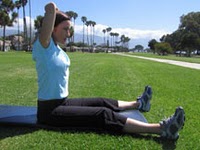 If the idea of having supple muscles and smooth, fluid movements – movements that convey youth and health, regardless of age – sounds appealing, then add flexibility training into your life, if you haven’t done so already, so that you may begin to enjoy the many benefits.
If the idea of having supple muscles and smooth, fluid movements – movements that convey youth and health, regardless of age – sounds appealing, then add flexibility training into your life, if you haven’t done so already, so that you may begin to enjoy the many benefits.
Flexibility is defined as the measure of a joints movement through a normal range of motion. A flexible joint has the ability to move through a greater range of motion so you’re much less likely to become injured in the course of your everyday activities and sports.
Flexibility training, or stretching, improves posture. Poor postural habits can cause your muscles and the connective tissue that surrounds them to mold into the positions you maintain throughout your day, (like the rounded shoulders that develop from spending too many hours in front of a computer). Stretching these short tight muscles helps realign the soft tissue structures, so it’s a lot easier to maintain good posture.
Probably the greatest benefit is the effect stretching has on the low back. By increasing the flexibility of your hamstrings, hip flexors, quadriceps, and other muscles that attach to the pelvis, you reduce the tension on the lumbar spine, so you’re much less prone to suffer from low back pain.
Researchers claim that stretching immediately before exercise doesn’t prevent injury; but stretching after training reduces muscle soreness, so stretch following your workouts, when your muscles are warmed up. Or, warm up your muscles by walking or doing cardio for five or ten minutes prior to stretching.
And, although there are a number of different stretching techniques, static stretching, which involves lengthening your muscles and tendons by holding a stretch for a period of time, is considered the safest and most effective.
To begin, focus on the muscle you want to stretch and move your body gently and gradually until you have reached the desired level of tension, accompanied by a feeling of discomfort but not pain. Breathe slowly and rhythmically and visualize your muscles and tendons lengthening as you stretch. Hold the position for 10-30 seconds, and then release.
Keep in mind that flexibility varies from person to person, and from joint to joint. One person may have flexible hamstrings and tight shoulders, while another may have a flexible spine but tight hip flexors. Genetics, age, activity levels, and gender all play a role in these differences. So tailor a program based on your needs; always stretch your entire body, but spend a little extra time on the muscles that tend to be a little stiffer, or that you use more in your activities. And over time you’ll find that your range of motion will improve and your flexibility will increase.
